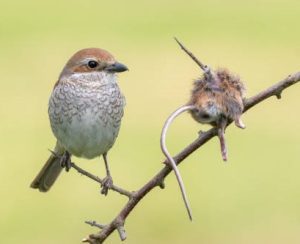A tiny bird with a very harsh call, known as shrikes, mostly seen in grey and brownish, might catch anyone’s attention in the first place. Although this tiny or medium-sized predatory bird belongs to the Laniidae family, it is mostly seen on three continents: Africa, Europe, and Asia. Specifically, more than 25 species of the genus Lanius represent the subfamily of true shrikes, Laniidae. The family, which was first represented by the French polymath Constantine Samuel Rafinesque in 1815, and the types of the genus Lanius introduced by Carl Linnaeus in 1758, include 34 species in four generations, including the genus Eurocephalus, which includes two white-crowned shrikes. A study published in 2023 found that the white-crowned shrikes were more closely related to the crows in the family Corvadie than they are to the Laniidae.

Image: Shrike Bird
Using their muzzle as a weapon, they catch and kill larger insects than them, such as Lizards, mice, even small birds, etc. Shrike impales its prey on a sharp object in such a way that the sharp object passes over between the prey. Hence this bird’s alias, butcher or throne bird; however, despite their predatory nature, shrikes often possess melodious songs and usually showcase both their padatory and musical skills, even though they are able to adapt to different environments.
This interesting bird has a very unusual and interesting character. A few strange facts about shrikes are the habit of impaling prey on thrones or any other sharp object and storing it so that they can consume it later. This particular process of storing food, or its behavior, is called “larder hoarding.”. Another strange thing is their ability to mimic the calls of other birds, mechanical sounds, etc., so they are surprisingly versatile. Even some shrike species have a reversed toe arrangement, with their first toe pointing backward. This feature actually belongs to a very uncommon group of passerine birds. This reverse toe helps shrikes grip and handle their impaled prey.
But why do shrikes impale their prey on sharp objects before consuming them?

Image: Female red-backed shrike (Lanius collurio) with a killed common vole.
A habit of impaling prey on sharp objects, mostly observed in shrikes, is related to their feeding behavior. By skewering their prey on thorns, spikes, or any other sharp objects, shrikes can easily tear it into smaller pieces. Even in this way, it also helps them store extra for their consumption and survival. Specifically, impaling prey on sharp objects allows shrikes to handle and consume a variety of prey easily, which helps them to survive in different environments. Two common visitors during the winter season in different subcontinents of India are the Isabelline Shrike (Lanius isabellinus) and the Brown Shrike (Lanius cristatus).
These birds are a widespread and diverse group of birds found in various habitats around the world. The most widespread species is the great grey shrike, also known as a northern shrike in Canada and the United States.
The evolutionary history of shrikes, like many bird species, spans millions of years. The exact time when shrikes were discovered is challenging because it involves the gradual process of avian evolution over geological time scales. whereas the fossils found by the geologist provide evidence of shrike birds’ existence a million years ago.
As a conclusion, shrikes are a group of engrossing birds belonging to the family Laniidae with unique characters and behaviors. It is amazing how their hunting style, which involves impaling victims on sharp things, produces enough food for them to eat. Shrikes are distributed globally, with diverse species inhabiting a range of environments across different continents. Their adaptive nature of being in different ecosystems and a versatile food diet help them to maintain their family.








0 Comments